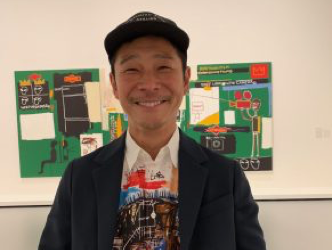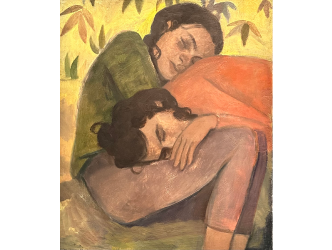The previous record for Basquiat was set in 2016 at 57.2 million dollars.
This was an enormous jump that pulled the African-American artist up into the ranks of the giants of the art market.
Since then, we’ve learnt that Maezawa set up a contemporary art foundation that has been running since 2012 in Japan.
He became even more famous on 18 September 2018 when he announced his plans to take part in the SpaceX mission to go to the moon scheduled for 2023. It’s a project established by Elon Musk in which he wants various artists to participate.
I met Maezawa on the occasion of the opening of the remarkable Basquiat exhibition at the Louis Vuitton Foundation in Paris.
He was wearing a shirt printed with a picture of “his” Basquiat.
He asked to see the questions before our interview.
But once he’d got into the swing of things he played the game completely and with simplicity, to the point of answering other related questions very spontaneously.
He displays a touching candour and sensitivity.
This short interview reflects the spirit of a dreamer in this unique individual; a successful businessman who also shows his emotions without pretence, who dares to say a painting can bring him to tears.
He seems sincere and willing to share his dreams with the entire world.
You bought a 1982 Basquiat on 18 May 2017 for 110.5 million dollars, a skull which is now on show at the Vuitton Foundation in Paris. Why exactly did you choose this Basquiat piece?
What other art do you collect?
Why is art important to you?
What is your next dream?
The interview took place at the Vuitton Foundation inside the Basquiat retrospective.
The Louis Vuitton Foundation in Paris is staging an exhibition dedicated to Jean Michel Basquiat (1960-1988), the hero of contemporary American painting, comprising 120 works that are emblematic of the artist. The ensemble of paintings and drawings presented here, together with the harmony of the exhibition layout, produce a show that is absolutely exceptional.
The curator Dieter Buchhart – who’s been behind all the major exhibitions of the artist’s work around the world in recent years – talks about this Parisian retrospective as being the “ultimate exhibition”.
The artistic director of the Vuitton Foundation, Suzanne Pagé, believes that the exhibition, by virtue of its scope, is committed to enhancing understanding of the fact that: “he was the first artist of a global society, who mixed popular culture with sophistication, the low with the high. He was also an extraordinary draughtsman and colourist.”
Observing his paintings and drawings up close, you can see that Basquiat designed each piece like a rebus.
Yes, paradoxical though it may seem, the paintings of Jean Michel Basquiat (1960-1988), the eternally young black American painter who cut his teeth as a graffiti artist on the streets of New York, are conceived according to a complexity that harks back to ancient art.
Erudition, codification, symbols… In his compositions, which despite having a central subject often resemble one big mess, everything has a specific meaning.
In 1996 Richard D. Marshall, the great New York art specialist of the 1980s in who is now deceased, explained in the artist’s catalogue raisonné:
“An analytical assessment of his ‘oeuvre’ reveals an artistic statement that is clear, intentional and cohesive with conscious and deliberate references to a number of recurring subjects, images and themes that dominate his paintings and drawings. These general categories of subjects include autobiography, black heroes comics and cartoons, anatomy, graffiti as well as carefully chosen words and phrases that refer to money, racism and death”. (1)
Explanations of five works by the curator Dieter Buchhart.
Untitled, 1982. Yusaku Maezawa collection.
Self Portrait with Suzanne, 1982.
Slave Auction, 1982.
Horn players. 1983.
Offensive Orange, 1982.
Riding with Death, 1988.
(1) Editions Enrico Navarra, 1996.
Donating=Supporting

Support independent news on art.
Your contribution : Make a monthly commitment to support JB Reports or a one off contribution as and when you feel like it. Choose the option that suits you best.
Need to cancel a recurring donation? Please go here.
The donation is considered to be a subscription for a fee set by the donor and for a duration also set by the donor.













